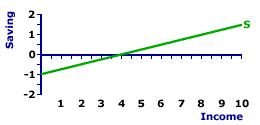
|
|
INTERCEPT, CONSUMPTION LINE: The intercept of the consumption line indicates autonomous consumption, consumption that does not depend on the level of income or production. This can be thought of as the baseline level of consumption that would be undertaken if income falls to zero. Autonomous consumption is affected by the consumption expenditures determinants, which cause a change in the intercept and a shift of the consumption line. The value of the intercept of the saving line is the negative of the value of the intercept of the saving line.
Visit the GLOSS*arama
|
|


|

|
                           SLOPE, SAVING LINE: The positive slope of the saving line is also termed the marginal propensity to save (MPS). This slope is greater than zero but less than one, reflecting induced saving and the Keynesian psychological law of consumer behavior that saving increases by less than the increase in income. The slope of the saving line provides the foundation for the slope of the leakages line used in the injections-leakages model. It thus also affects the magnitude of the multiplier process. | Saving Line | 
|
The saving line, also termed propensity-to-save line or saving function, shows the relation between saving and income for the household sector. The income measure commonly used is national income or disposable income. Occasionally a measure of aggregate production, such as gross domestic product, is used instead.A representative saving line is presented in the exhibit to the right. This green line, labeled S in the exhibit, is positively sloped, indicating that greater levels of income generate greater saving by the household sector. This positive relation corresponds to the fundamental psychological law of Keynesian economics. The saving line graphically illustrates the saving-income relation for the household sector, which is the foundation of the leakages line used in Keynesian economics to identify equilibrium income and production. The slope of the saving line presented here is positive, but less than one. In fact, the slope of the saving line is numerically equal to the marginal propensity to save. In this case the slope is equal to 0.25. The positive slope reflects induced saving--more income means more saving. It also reflects the basic Keynesian psychological law. Click the [Slope] button to illustrate. To illustrate the equality between slope and the marginal propensity to save, consider the equations for each. The slope of the saving line is specified as the "rise" over the "run." The rise is the change in saving measured on the vertical axis and the run is the change in income measured on the horizontal axis. | slope | = | rise
run | = | change in saving
change in income |
The marginal propensity to save (MPS) is the incremental change in saving resulting from an incremental change in income. | MPS | = | change in saving
change in income |
The slope of the saving line is the marginal propensity to save, they are one and the same.The positive slope of the saving line reflects induced saving, which is saving that depends on the level of household sector income. If the household sector receives more income, then it is induced to undertake additional saving. Of course, a drop in income induces the household sector to reduce saving.

Recommended Citation:SLOPE, SAVING LINE, AmosWEB Encyclonomic WEB*pedia, http://www.AmosWEB.com, AmosWEB LLC, 2000-2024. [Accessed: April 27, 2024].
Check Out These Related Terms... | | | | | | | | | | | | | | |
Or For A Little Background... | | | | | | | | | |
And For Further Study... | | | | | | | | | | | | | | | |
Search Again?
Back to the WEB*pedia
|



|

|
BROWN PRAGMATOX
[What's This?]
Today, you are likely to spend a great deal of time searching the newspaper want ads trying to buy either a coffee cup commemorating the first day of winter or a video game player. Be on the lookout for high interest rates.
Your Complete Scope
This isn't me! What am I?
|

|
|
Cyrus McCormick not only invented the reaper for harvesting grain, he also invented the installment payment for selling his reaper.
|

|
|
"Nothing is a waste of time if you use the experience wisely. " -- Auguste Rodin, Sculptor
|

|
FTSE-100
Financial Times Stock Exchange 100 stock index (UK)
|

|
|
Tell us what you think about AmosWEB. Like what you see? Have suggestions for improvements? Let us know. Click the User Feedback link.
User Feedback
|


|


